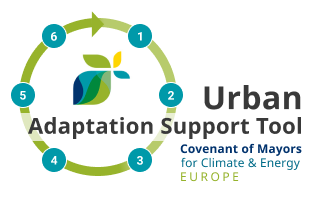
Getting started
Adaptation to climate change in urban areas
Cities are vital centres of economic and cultural activities in Europe. They are already affected by climate hazards such as intense precipitation and heat waves, which under the changing climate are projected to become more intense and more frequent. As the climate change progresses, cities need to adapt in order to remain liveable, functional and prosperous in the future. Adaptation is the process of adjustment to the actual or expected climate and climate hazards, seeking to reduce the negative impacts or exploit beneficial opportunities. Similarly as in the case of reducing greenhouse gas emissions, there is also urgency in preparing for the unavoidable impacts of climate change. Cities need to act now to avoid or reduce weather-related deaths (e.g. due to heat waves) and economic losses from climate-related extremes in the future. By April 2020, close to 3,000 cities and towns across Europe had committed to taking action on adaptation under the Covenant of Mayors, and this number is increasing.
The projected increase in frequency and intensity of climate-related hazards – e.g. flooding, heatwaves, wildfires and droughts – requires response not only from the national governments but also from local authorities. Adaptation can be a strongly localised process due to the particular geographical, socio-demographic or economic characteristics of a given place. The city and town authorities have the best knowledge of the locally occurring hazards (see Step 2.1) and the specific causes of vulnerability in the local area (e.g. population characteristic, types of infrastructure, most economically important sectors etc; see Step 2.3) and therefore are well-placed to address them.
Adapting to climate change at the local level – through avoidance or reduction of risks – makes economic sense. According to E3G, the economic costs from extreme weather events to EU cities could reach over EUR 190 billion annually by 2070, unless action is taken. For example in Copenhagen, the flooding of the city centre due to a major rainfall event in 2011 caused damage over 6 billion DKK (more than EUR 800 million). The potential costs of future rainfall events were so high that they justified spending of 12 billion DKK on over 300 stormwater management projects across the city over the span of 20 years.
In addition, top credit rating agencies increasingly consider climate change preparedness of cities in assessing the risk of lending them money. Also, cities that are safe from natural disasters and pleasant to live in (e.g. through provision of green space) tend to attract and retain more investment and skilled workforce.
Reports
Relevant tile
- Urban adaptation in Europe: how cities and towns respond to climate change
- Climate change response in Europe: what's the reality? Analysis of adaptation and mitigation plans from 200 urban areas in 11 countries
- Towards the Metropolitan City: adaptation strategies to climate change using new technologies and integrated approaches for e-governance and spatial planning decision-making
- Climate change adaptation: Empowerment of local and regional authorities, with a focus on their involvement in monitoring and policy design
- Climate change adaptation in Delta Cities
- Climate Change and Cities: Second Assessment Report of the Urban Climate Change Research Network
